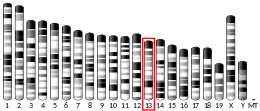Solute carrier family 17 (organic anion transporter), member 3 is a protein that in humans is encoded by the SLC17A3 gene.[5]
Function
The protein encoded by this gene is a voltage-driven transporter that excretes intracellular urate and organic anions from the blood into renal tubule cells. Two transcript variants encoding different isoforms have been found for this gene. The longer isoform is a plasma membrane protein with transporter activity while the shorter isoform localizes to the endoplasmic reticulum.[5]
See also
References
- 1 2 3 GRCh38: Ensembl release 89: ENSG00000124564 - Ensembl, May 2017
- 1 2 3 GRCm38: Ensembl release 89: ENSMUSG00000036083 - Ensembl, May 2017
- ↑ "Human PubMed Reference:". National Center for Biotechnology Information, U.S. National Library of Medicine.
- ↑ "Mouse PubMed Reference:". National Center for Biotechnology Information, U.S. National Library of Medicine.
- 1 2 "Entrez Gene: Solute carrier family 17 (organic anion transporter), member 3".
Further reading
- Polasek O, Jeroncić I, Mulić R, Klismanic Z, Pehlić M, Zemunik T, Kolcić I (2010). "Common variants in SLC17A3 gene affect intra-personal variation in serum uric acid levels in longitudinal time series". Croat. Med. J. 51 (1): 32–9. doi:10.3325/cmj.2010.51.32. PMC 2829186. PMID 20162743.
- Dehghan A, Köttgen A, Yang Q, Hwang SJ, Kao WL, Rivadeneira F, Boerwinkle E, Levy D, Hofman A, Astor BC, Benjamin EJ, van Duijn CM, Witteman JC, Coresh J, Fox CS (2008). "Association of three genetic loci with uric acid concentration and risk of gout: a genome-wide association study". Lancet. 372 (9654): 1953–61. doi:10.1016/S0140-6736(08)61343-4. PMC 2803340. PMID 18834626.
- Ruddy DA, Kronmal GS, Lee VK, Mintier GA, Quintana L, Domingo R, Meyer NC, Irrinki A, McClelland EE, Fullan A, Mapa FA, Moore T, Thomas W, Loeb DB, Harmon C, Tsuchihashi Z, Wolff RK, Schatzman RC, Feder JN (1997). "A 1.1-Mb transcript map of the hereditary hemochromatosis locus". Genome Res. 7 (5): 441–56. doi:10.1101/gr.7.5.441. PMID 9149941.
- Jutabha P, Anzai N, Kitamura K, Taniguchi A, Kaneko S, Yan K, Yamada H, Shimada H, Kimura T, Katada T, Fukutomi T, Tomita K, Urano W, Yamanaka H, Seki G, Fujita T, Moriyama Y, Yamada A, Uchida S, Wempe MF, Endou H, Sakurai H (2010). "Human sodium phosphate transporter 4 (hNPT4/SLC17A3) as a common renal secretory pathway for drugs and urate". J. Biol. Chem. 285 (45): 35123–32. doi:10.1074/jbc.M110.121301. PMC 2966126. PMID 20810651.
- Stark K, Reinhard W, Grassl M, Erdmann J, Schunkert H, Illig T, Hengstenberg C (2009). "Common polymorphisms influencing serum uric acid levels contribute to susceptibility to gout, but not to coronary artery disease". PLOS ONE. 4 (11): e7729. Bibcode:2009PLoSO...4.7729S. doi:10.1371/journal.pone.0007729. PMC 2766838. PMID 19890391.
- Jutabha P, Anzai N, Kimura T, Taniguchi A, Urano W, Yamanaka H, Endou H, Sakurai H (2011). "Functional analysis of human sodium-phosphate transporter 4 (NPT4/SLC17A3) polymorphisms". J. Pharmacol. Sci. 115 (2): 249–53. doi:10.1254/jphs.10228sc. PMID 21282933.
- Melis D, Havelaar AC, Verbeek E, Smit GP, Benedetti A, Mancini GM, Verheijen F (2004). "NPT4, a new microsomal phosphate transporter: mutation analysis in glycogen storage disease type Ic". J. Inherit. Metab. Dis. 27 (6): 725–33. doi:10.1023/B:BOLI.0000045755.89308.2f. PMID 15505377. S2CID 20942710.
This article incorporates text from the United States National Library of Medicine, which is in the public domain.
This article is issued from Wikipedia. The text is licensed under Creative Commons - Attribution - Sharealike. Additional terms may apply for the media files.



